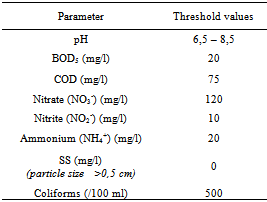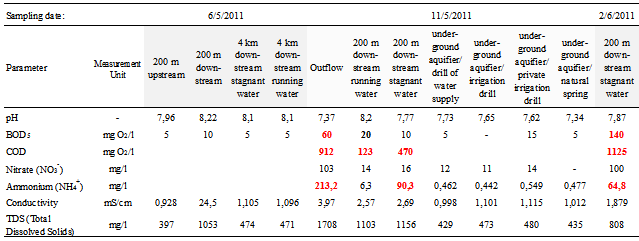-
Paper Information
- Next Paper
- Previous Paper
- Paper Submission
-
Journal Information
- About This Journal
- Editorial Board
- Current Issue
- Archive
- Author Guidelines
- Contact Us
World Environment
p-ISSN: 2163-1573 e-ISSN: 2163-1581
2013; 3(3): 94-101
doi:10.5923/j.env.20130303.04
Water Quality Monitoring and Assessment of a Small SWM’s Produced Leachates
Antigoni Zafirakou1, Eleftherios Gaitanelis1, Maria Gianni2
1Department of Civil Engineering, Aristotle University of Thessaloniki, Thessaloniki, 54124, Greece
2Department of Business Administration, University of Macedonia, Thessaloniki, 54124, Greece
Correspondence to: Antigoni Zafirakou, Department of Civil Engineering, Aristotle University of Thessaloniki, Thessaloniki, 54124, Greece.
| Email: |  |
Copyright © 2012 Scientific & Academic Publishing. All Rights Reserved.
The water quality of surface and groundwater aquifers in the vicinity of a small solid waste management (SWM) is being investigated in this paper, with respect to the leachates’ treatment. The operation of a ten year old waste management establishment in an agricultural area of northern Greece serves as our case study. We are investigating, after an accident of overflow of the produced leachates, the treatment plant and its efficiency. Water samples from the immediate vicinity of the facility have been collected and analyzed in the laboratory of Environmental Engineering and Planning, at the department of Civil Engineering of the Aristotle University of Thessaloniki. The laboratory results were compared with the environmental limits for water use in irrigation (higher than those for drinking water). The analyses indicated that the samplings from the facility’s outflow and the nearest to the landfill water aquifer were found polluted, even several months after the overflow. Since the water sample taken from the landfill’s outflow exceeded the environmental limits, the contamination is directly connected to the landfill and the leachates’ treatment. The function of municipal waste landfills can prove beneficial and be accepted by local communities, only if they comply with the environmental laws.
Keywords: Solid Waste Management, Sanitary Landfills, Leachates Treatment, Aquifer Pollution, Water Quality Monitoring
Cite this paper: Antigoni Zafirakou, Eleftherios Gaitanelis, Maria Gianni, Water Quality Monitoring and Assessment of a Small SWM’s Produced Leachates, World Environment, Vol. 3 No. 3, 2013, pp. 94-101. doi: 10.5923/j.env.20130303.04.
Article Outline
1. Introduction
- Solid waste management in the past, in Greece and other developed countries, was limited to the transportation of the wastes from the production source (households, industries etc) to uncontrolled waste disposal places. This policy though, had severe negative effects on the environment (i.e. groundwater pollution, air pollution from waste combustion) [1],[2],[3]. This is an important environmental issue worldwide, as the production of urban and industrial wastes increases dramatically year after year and landfills appear in every corner of the earth. This situation improved significantly in the mid 90’s, by organizing the municipal solid waste management, which covers 85% of the total solid wastes. The new national environmental strategy in Greece (following the Directive 2008/98/EE)[4] is aiming firstly at shutting down all the uncontrolled landfills, followed by the environmental restoration of the areas and ultimately the creation of new controlled waste disposal places, known as sanitary landfills[5].In essence, solid waste management comprises of a series of multiple steps. It includes the selection of the landfill site, based on various (hydro-geological, economical and social) criteria, the collection and transfer of non-recyclable materials to the landfill site, the selection of the leachates’ treatment method (based primarily on the volume of the solid wastes and their synthesis) and the selection of the treated leachates’ recipient, where they return to nature. The selection of the site where a landfill will be constructed is the first step towards the solid waste management of an area. The facility must be away from inhabited and environmentally protected areas, but yet accessible by main roads. The decision is based on hydrological and meteorological data. A geotechnical study must also be conducted, in order to identify the properties of the soil and the existence of aquifers in the nearby area. The capacity of the facility (size and methods used), as well as the duration of its operation, are based on the estimation of the population of the communities that will be served. The objective of the landfills’ construction is not only the disposal of wastes but also the collection and treatment of the leachates and biogas, as well as the transportation of the latter to energy plants[6]. The operation of a SWM facility in northern Greece is used as an example. We are investigating to what degree it has met the prerequisite operational standards, and to what extent it has had a negative impact on the surrounding environment and, in particular, the surrounding water aquifers, which serve as irrigation sources. After gathering information on the landfill’s construction and operation, this study focuses on evaluating the extent of pollution from the facility’s overflow in nearby streams and wells, after an accident in fall of 2010, when excessive rainfall overloaded the storage tanks of the facility and leachates escaped into the neighboring croplands.
2. Construction and Operation of the SWM Facility
- The landfill of Katerini, the capital of the Prefecture of Pieria, in the Region of Central Macedonia of Greece served as our case study. The sanitary landfill of Katerini was approved by the Greek Ministry of Environment, Energy and Climate Change and started the construction of the first cell in 1998. Its operation started in March 2001. During the first phase, cell 1 with a capacity of 190,000 m³ (Figure 1) was in operation for 7.5 years. In 2008, the construction of the second phase began[7], with the addition of cells 2 and 3 of a total capacity of 153,000 m³ (Figure 1). This would extend the lifetime of the landfill’s operation for 4.5 more years. This waste management facility was designed to receive 120 m3 of wastes daily, from a population of 120,000 permanent residents and seasonal tourists.
 | Figure 1. Google map of the sanitary landfill of Katerini (2012) |
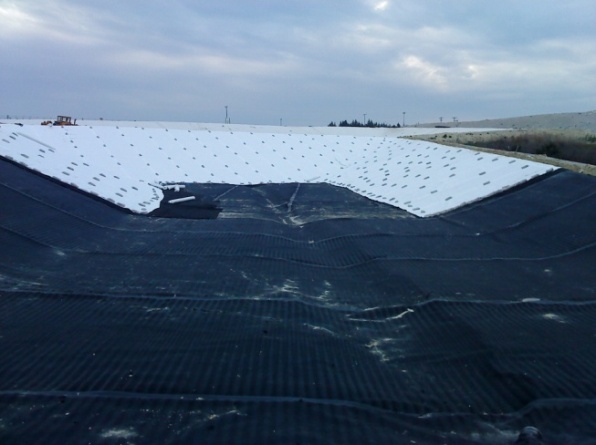 | Figure 2. Construction works of the 2nd phase at the landfill of Katerini. Artificial sealing in the 2nd cell of the landfill. (ADT-Omega ATC, 2008) |
 | Figure 3. Construction works of the 2nd phase at the landfill of Katerini. Leachates collection pipe. (ADT-Omega ATC, 2008) |
 | Figure 4. Leachates’ flow chart of the landfill of Katerini |
 | Figure 5. Container 1. Pre-filtering of the leachates |
 | Figure 6. Container 2. Treatment of the leachates |
3. Overflow of the Leachates
- The first cell of the landfill of Katerini was designed to operate for 7.5 years and finally operated for 10 years, resulting in overfilling of the cell and in the belated start of its covering with impermeable surface. During the period of February to March of 2010, as the construction of the second phase of the landfill was still in progress, storage tank 2 was full of the leachates coming from cell 2, which was already put in operation (Figure 7). Due to extensive rainfall, storage tank 2 overloaded with rainwater too. Due to the fact that the RO plant was in recess at that period of time, the leachates were directed through underground pipes from storage tank 2 to cell 3 (Figure 8). As a result the leachates remained unprocessed and both cell 3 and storage tank 2 were filled. Shortly after, while the first cell was still uncovered, another intense rainfall in October 2010, overloaded the storage tanks, and unprocessed leachates escaped into the neighbouring land.Apart from recycling leachates between different cells on a landfill site, leachates can be disposed of in three ways[16]: (a) to sewer, where there is likely to be a restriction in the ammonia concentration, red listed substances, methane and compounds that might affect the sewer pipes, (b) to river/water course, where, in addition to the above restrictions, there are limits on BOD, COD, suspended solids, chloride concentration and nitrate, and (c) by road tanker to an alternative treatment site, which assumes that the first two options are not available, since the cost is high. The second solution was selected for the landfill of Katerini due to its proximity to Bufolakas stream.It came to our attention that, after the intensive rainfall of October 2010, a large amount of unprocessed leachates was driven to Bufolakas stream, putting the surrounding aquifers in great environmental risk. As google map in Figure 1 shows, there are pristine conditions in the area, which deserve to remain unspoiled. It is also worth mentioning that this water stream is used for irrigation by the neighboring croplands and farms. Consequently, a possible pollution could cause harmful effects to the agricultural products as well as to public health. In order to determine the extent of the environmental impact, we proceeded in taking water samples from surface and groundwater sources, examined their physicochemical properties and content of heavy metals in the laboratory.
 | Figure 7. The 2nd cell of the landfill of Katerini in operation |
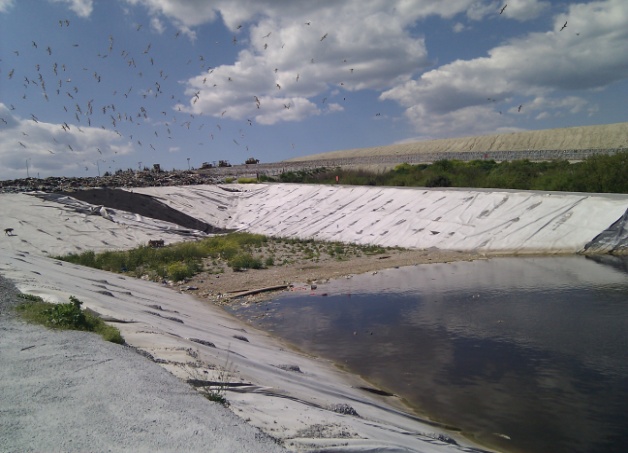 | Figure 8. Leachates and rainwater in the 3rd cell |
4. Laboratory Analyses
- With our mind on the investigation of plausible water pollution in the neighbouring aquifers and streams of the landfill of Katerini, three different samplings were initially collected during the period of May-June 2011 (Table 1), from groundwater and surface water upstream and downstream from the solid wastes facility (maximum distance from the landfill 6 km). The supposedly processed leachates from the landfill are allowed to join the stream that sets off from the spring of Bufolakas, upstream from the landfill, and end up in the sea of Katerini. The intersection of these two streams is 200 m downward from the landfill’s outlet. In the following table (Table 1), the sampling points’ distances are given with respect to the landfill’s outflow.These laboratory analyses were performed at the laboratory of Environmental Engineering and Planning, at the Department of Civil Engineering, of the Aristotle University of Thessaloniki, seven months after the accident. From the parameters that were tested, those that indicate the existence of pollution are nitrate ions (NO3-), ammonium ions (NH4+), BOD5 and COD. The experimental results were compared with the environmental limits for water use in irrigation (higher than those for drinking water) according to Pieria’s Prefectural Decision[17], given in Table 2.
|
|
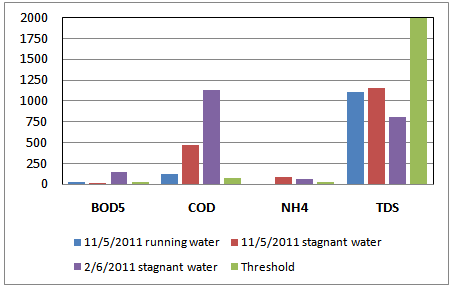 | Figure 9. Surface water measurements 200m downstream of the facility |
|
 | Figure 10. Lab analyses at the outflow of the solid waste facility |
|
 | Figure 11. Lab analyses of heavy metals at the outflow of the solid waste facility |
- More analytically, the physicochemical laboratory results (Table 3) show that the threshold limits are exceeded for BOD5 and COD at the landfill’s outflow, when compared with Table 2. There is an observed increase in these two parameters from the results of May-June 2011 (Table 1), which indicates that the leachates flowing out from the landfill remain untreated. The ammonium ions remained below the limits in these measurements, even at the exit. This comparison is better described in Figure 10, where the concentration limits for irrigational use are exceeded in most cases, and the total dissolved solids are approaching the major degree of irrigation restrictions, according to the Joint Ministerial Decision 145116/02-02-2011, Government Gazette Β΄354/8-3-2011[17].On the other hand, the analysis of heavy metals from the same samples show that the environmental limits, set by Pieria’s Prefectural Decision 5662[17] and the Joint Ministerial Decision of 2011[18], are not exceeded, as shown in Table 4 and Figure 11, with the only exceptions of Mn, and slightly Cr and Cu. Analyses on the heavy metals, performed in a private laboratory on behalf of the solid waste management of Katerini in September of 2010 (before the accident), before and after the reverse osmosis treatment (inflow – outflow), are also shown in Table 4. No alarming values were detected then for the heavy metals at the exit of the landfill. It is worth mentioning the treatment is quite effective with respect to the heavy metals, especially in terms of iron and zinc, but not for manganese. Literature focuses on the reduction of heavy metals in the produced leachates[19].
5. Conclusions – Suggestions
- In our study, we investigated the operation of a small solid waste management facility and the effectiveness of the leachates’ treatment. Due to an excessive rainfall in October 2010, untreated leachates escaped from the sanitary landfill of Katerini (in N. Greece) into the farmlands of the area. This accident raised the concern of the local community about the operation of the landfill and the quality of its outflow. After a closer investigation of the facility, its construction and operation, it seems that the accident was caused by the overloading of the disposal areas, the longer operation of the facility than it was designed for, as well as the bad maintenance of the treatment plant of reverse osmosis. The deficient attention of the authorities, in combination with the excessive rainfall in October 2010, forced the leachates to overflow the storage tanks and escape into the environment.The samples that we analyzed, seven to seventeen months after the accident, indicated that the water aquifers next to the landfill’s outflow were contaminated. The concentration of COD, BOD5 and ammonium ions exceeded the threshold values set for irrigation. However, no alarming measurements of heavy metals were documented in these samples.The environmental impact on the surrounding water aquifers is significant, as the area is agricultural and the stream of Bufolakas is the main source of water for irrigation. Taking measures to protect the water stratum from such accidents is of profound importance. The most important step towards the environment’s protection is the flawless operation of the facility, which implies proper maintenance, no overloading, but firstly optimal design of the leachates treatment, following the environmental laws. The membranes of the primary and secondary processing in the RO plant may easily get clogged or injured, given that the leachates carry a high content of suspended solids and pollutant loads, and consequently the treatment is not effective. Since weather cannot be constrained, the solid waste management should prevent accidents by avoiding breakdowns or by having emergency plans available at any time. Some ideas towards this direction are to construct secondary storage tanks or explore other routes of disposal of untreated leachates. First and foremost, the treatment method of a SWM facility must be selected very carefully, staying focused primarily on the quality of the outflowing leachates, and secondly on the cost of operation. A method that assures prevention of excess parameter values at a very high percentage is the pre-treatment of the leachates with the use of a ventilation tank (biological treatment) and of a tank of natural sedimentation, as it has been applied widely by engineers. Pre-treatment of the leachates can also be achieved in a storage pond combined with wetlands[20]. Membrane filtration processes in combination with physicochemical processes, such as adsorption or coagulation, could effectively alleviate membrane fouling [15]. Particles-free pretreated wastes prevent membranes getting overloaded and clogged, and thus prolong their lifetime. Regular monitoring of the outflow from the facility is not only the safest method to keep control of the quality of the leachates and their treatment’s effectiveness, in addition to the contamination level of the surrounding water bodies, but also a requirement by law since 1999[6].In conclusion, the operation of solid waste treatment plants should always be reliable and flawless, so that the public rests assured that the liquefied wastes flowing into the surface and subsurface waters are treated and beyond any suspicion for pollution source.
 Abstract
Abstract Reference
Reference Full-Text PDF
Full-Text PDF Full-text HTML
Full-text HTML